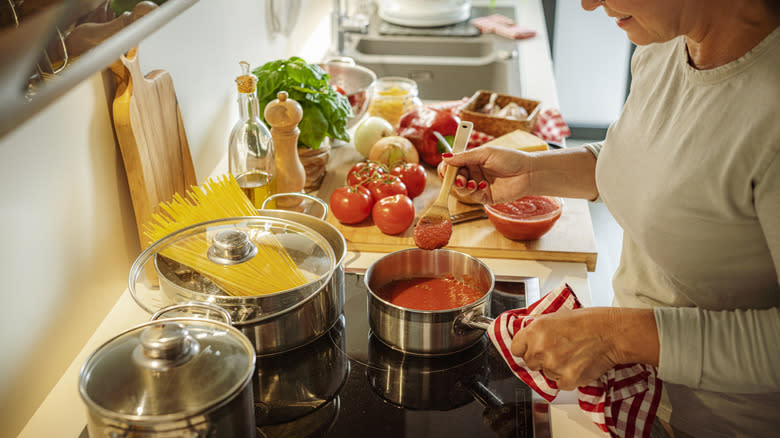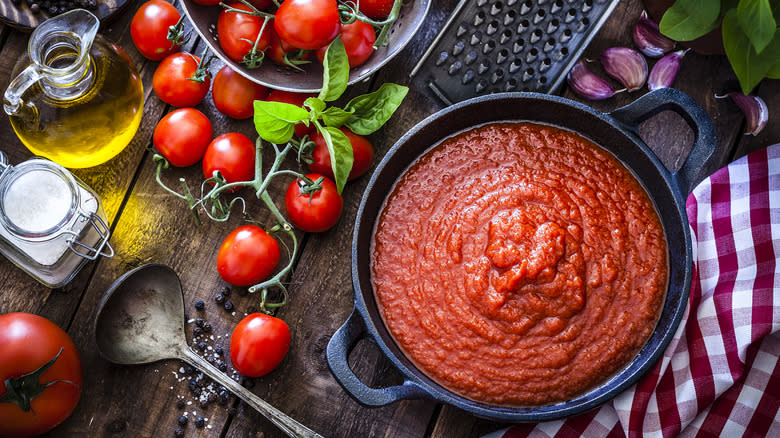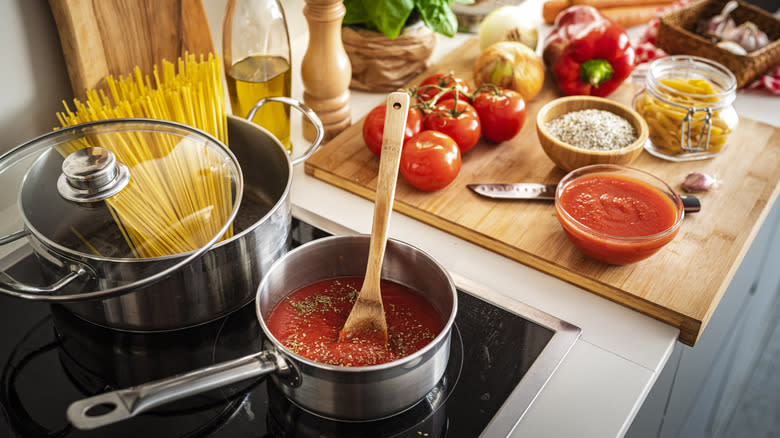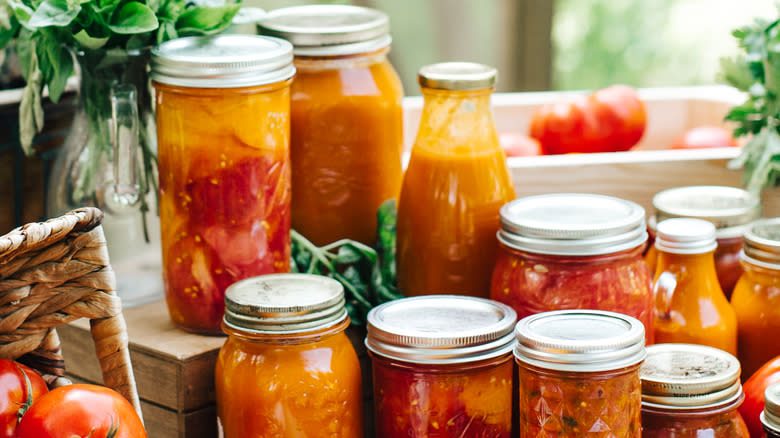Spaghetti Sauce Vs Marinara: Everything You Need To Know

Think back to Grandma's kitchen when she would stay home on a Sunday and make her signature tomato sauce. Most of us just indulged in the fruits of her labor, ignorant of the sauce type we were enjoying, but did you know there is an array of sauces ranging from simple recipes to all-day affairs? Tomato tom-ah-to indeed.
With this in mind, we decided it was a great idea to teach you about two of the main tomato-based sauces in the Italian pantheon: marinara sauce and spaghetti sauce. Yes, there is a difference -- a big one. And don't get us started on other types, such as bolognese or "gravy". Seemingly interchangeable, there is a world of Italian knowledge, history, and ingredients that flow between marinara and spaghetti sauce. Featuring their own signature ingredients and prep methods, marinara and spaghetti sauce diverge greatly on their road to sauce-dom. But what exactly sets them apart? Are there certain dishes where a specific sauce should be used?
To answer these questions for you, we researched the origins, ingredients, and cultural significance of each sauce to bring you a guide that will help you understand their differences and what makes them each so great. From the charming kitchens of southern Italy to the bustling streets of New York City, every sauce tells a story, and we're here to relay their tales. Grab your wooden spoon and prepare to be schooled in the world of tomato sauces, where ingredients, textures, and maritime backgrounds create variety and flare.
Read more: 12 Vegetables And Fruits That Used To Look Very Different
The Origins Of Marinara Sauce

With a strong foundation in Southern Italy, the origins of marinara are definitely murky, but we can trace some of its history back to Naples. In the 16th century, sailors returning from the New World brought tomatoes home with them, paving the way for a foundational aspect of Italian cuisine.
Looking at the etymology of the word, it's amazing most never see the connection between marinara and mariner, hinting at its association with the sea. Derived from the Italian word "marinaro," meaning sailor, it's been said that Neapolitan sailors and merchants created marinara sauce as a quick and easy meal to enjoy during their travels. The truth is left unknown, but the clear connection to sea-faring life stands firm.
However, marinara shifted from a staple in Italy back to its tomato roots in the United States, as Italian immigrants brought their culinary heritage with them. Today, marinara is a cherished aspect of Italian-American cuisine, acting as a star in dishes such as spaghetti, smothered over pizza, or used as a dipping sauce for delicious garlic and cheesy breads alike. Who knew such a simple fruit would change the course of Italian history and the world?
The Origins Of Spaghetti Sauce

Just like marinara, the story of spaghetti sauce is pretty similar, as we just learned tomatoes hit the shores of Italy in the 16th century. Also known as "ragù", spaghetti sauce has the same base as marinara, but this option offers a more complex treat. Over the years, it has evolved into something more than simply tomatoes and some spices, as family recipes have captured the essence of marinara and added their own unique twists.
While Italian immigrants brought their marinara to U.S. shores, this shift in location also created a shift in the recipe. Spaghetti sauce became something akin to comfort food, with many adding in extras such as ground meat, onions, peppers, and atypical spices. Thicker, more robust, and far more complex to cook, spaghetti sauce made a name for itself in its new location. No matter the recipe or innovative twist, you'll find spaghetti sauce on heartier pasta, lasagna, and many more iconic dishes.
However, it's important to note that spaghetti sauce should not be confused with bolognese, which is from northern Italy and focuses on the meat instead of the tomatoes. Spaghetti sauce is still tomato-centered, with the other additions merely adding to the acidity and quintessential flavors.
How Are Spaghetti Sauce And Marinara Different?

The main distinction between marinara and spaghetti sauce lies primarily in their ingredients, but preparation methods play a factor, too. Marinara is the OG sauce with simple prep and fewer ingredients. It typically consists of tomatoes, garlic, and olive oil, with herbs such as basil and oregano. You may occasionally find other additions, such as onions, but for the most part, marinara is your basic girl.
She doesn't take long to get ready for a night out either, as marinara is typically simmered gently for a short period of time to preserve the freshness of the tomatoes and herbs. This shorter cooking time makes for a lighter, brighter sauce with a thinner consistency compared to spaghetti sauce. With its simpler profile, marinara is often used as a base for pizza, certain pasta dishes, and seafood, allowing the natural sweetness of the tomatoes and herbs to shine.
In contrast, spaghetti sauce is that friend who tries on a lot of outfits and takes forever to get ready. Typically a hearty, meat-based option, spaghetti sauce usually features ground beef or pork, onions, garlic, carrots, and celery within its tomato base, plus an array of herbs and spices depending on recipe and preference. This sauce takes its time, as it's simmered slowly over low heat for several hours. With a rich, chunky consistency, this sauce is heartier and way more substantial, making it a better choice for dishes like spaghetti (duh) or lasagna.
What Is The Difference In Taste And Texture Between Spaghetti Sauce And Marinara?

While both tomato-based sauces, there is a world of difference in taste and texture between marinara and its successor. Marinara has fewer ingredients and is very tomato-focused. Its flavor profile is lighter, characterized by the bright acidity of tomatoes and the fragrant herbaceousness of basil and oregano. Its texture tends to be smoother and more liquid compared to spaghetti sauce, with a thinner consistency that coats pasta delicately rather than weighing it down. The same can be said of the flavor profile and your stomach, allowing you to eat more without feeling full.
Spaghetti sauce differs greatly from marinara, with its thick consistency from the meat and added ingredients. These extras add more complexity to the flavor profile, as well, featuring a meaty richness embedded within the tomato base. The vegetables offer added texture, too, something you won't ever find within marinara's thin consistency. While marinara leans acidic, spaghetti leans savory, but that richness can weigh down a meal pretty quickly. While marinara can offer herbaceous flavors, spaghetti sauce is far more complex, especially when it comes to recipe variety. Depending on your palate and dish of choice, each can offer flavor and flare to your Italian favorites.
What's The Nutritional Value And Price Of Spaghetti Sauce And Marinara?

We don't think of tomato-based sauces as healthy, as they're usually accompanied by a heavy helping of pasta, but overall, each sauce has its positives and negatives in the health world. Since marinara is essentially tomatoes and herbs, this sauce seems to be the healthier of the two when it comes to calories and fat content. Its spaghetti sauce counterpart can have more calories and fat from its meat additions, but also features added protein, along with vitamins and minerals from the vegetables. It's important to note that store-bought versions can contain a lot of sugar and preservatives, so be sure to check the label if you're not making a homemade sauce.
In terms of pricing, these sauces can vary depending on factors such as brand, if you're buying in-store, and quality of ingredients and region if you're making homemade sauce. If you're cooking your own sauce, marinara tends to be more affordable since it features fewer ingredients and no meat. Additions to spaghetti sauce, such as ground meat and an array of veggies and spices, can increase your total at checkout.
For store-bought options, the jury is out on which item is cheaper, as pricing varies between brands and additions within the sauce. Both sauces can be found for under $3 at some retailers and well over $10 at others. Read your labels and decide which brand is right for your dish and your budget.
How Do You Store Spaghetti Sauce And Marinara?

While there are a ton of differences when it comes to marinara and spaghetti sauce, one similarity we can find is storage. Both sauces can be stored in airtight containers and refrigerated for short-term use. However, we don't suggest refrigeration for more than five to seven days.
If you need your sauces to last longer, stick them in the freezer. Be sure to allow both sauces to cool before sealing them in freezer-safe containers or even resealable bags. We also suggest labeling your containers with dates to ensure they don't go bad. Frozen tomato sauces can typically last for three to four months if stored correctly.
When you're ready to use your frozen sauce, the prep is easy. Thaw your container in the refrigerator overnight, allowing the sauce to naturally return to its liquid state. If you're in a pinch for time, you can also place your container in a bowl of cold water, then transfer it to a pot and warm it on the stove.
Read the original article on Daily Meal

